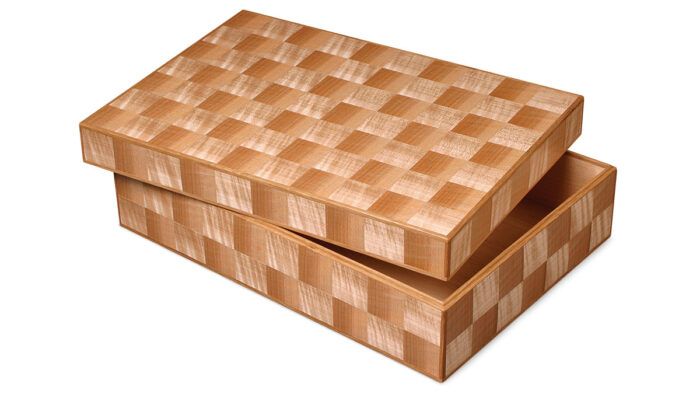Elegant Veneered Boxes
Veneer creates striking patterns, yet construction is straightforward.

Synopsis: Seth Janofsky’s veneered box is relatively simple in design, but the figured maple parquet veneer makes it especially striking. The box itself is built with tongue-and-groove joinery. Both the box and veneer can be made on the tablesaw. Janofsky gives step by step instructions for cutting the maple squares, piecing them together, and cutting the veneer strips. Then he takes readers through the process of applying the veneer to the box and binding it with oak strips. A companion Master Class gives directions for a second box, which features an intricate pattern of cut-out leaves.
When I have a bit of time to work on a special project, I like to make a beautiful box. It’s manageably small yet involves a fair amount of interesting detail work. One of my favorite designs is covered in a parquet of figured-maple squares.
I originally made boxes like these for collectors of netsuke (small carved objects of stone, wood, or ivory), but of course they can be used for just about any collection of small things.
The box itself is built much like a drawer, with tongue-and-groove joints for the corners and the bottom held in a groove. You can make everything, including the veneers, on the tablesaw.

Although conceptually simple, a parquet pattern can be difficult to execute precisely. In theory, you could cut many squares of veneer and piece them together into a sheet. But I find advantages to cutting blocks of maple, gluing them together, and then cutting that piece into strips of parquet that are glued into sheets.
This method keeps the veneer squares in an orderly sequence relative to the piece of wood from which they came. It creates a surface made more interesting by its display of multiple grain, figure, and color patterns. This box has three patterns at work even though it uses only one type of wood. The first pattern comes from the primary grain lines at right angles to each other in the parquet squares, the second from the maple’s fiddleback figure, the third from the difference in color between the sap and heartwood areas.
Of course, parquet isn’t the only covering for an elegant box. You also can use plain book-matched or slip-matched veneers, or you can create a unique scrollsawn marquetry design.
There are a number of ways to configure a box. The one described here has a top rabbeted to mate with the bottom, with the joint about two-thirds of the way up the side. I use binding—a narrow strip of white oak glued along all the edges—which harmonizes nicely with the maple veneer.

Make the sheets of veneer first
This box starts with the parquet veneer. The parquet began as a piece of figured maple about 1-3/4 in. thick by 3-1/2 in. wide by 20 in. long. The quartersawn side had the most consistent figure, so it was the face that yielded the parquet pattern.
A piece this size will produce enough veneer to cover a box approximately 101⁄2 in. wide by 15 in. long by 4-1/2 in. tall in a pattern of 1-1/2-in. by 1-1/2-in. squares. The exact size will be determined by the actual dimensions of the parquet sheets and the width of the oak edging.

From Fine Woodworking #192
To view the entire article, please click the View PDF button below.
Fine Woodworking Recommended Products

Bahco 6-Inch Card Scraper

Suizan Japanese Pull Saw

Whiteside 9500 Solid Brass Router Inlay Router Bit Set








Comments
I did not follow the parquetry procedure for the making of the lovely pattern. I bought this book to make all the projects, but, this one of the parquetry veneer is not too clear on how to make the cuts. Can someone clear that up (maybe Seth Janofsky) about the crosscuts of the maple to make two lengths of about 10 inches. And then how to orient the blocks. I am a stroke patient, trying to recover my woodworking skills.
Log in or create an account to post a comment.
Sign up Log in